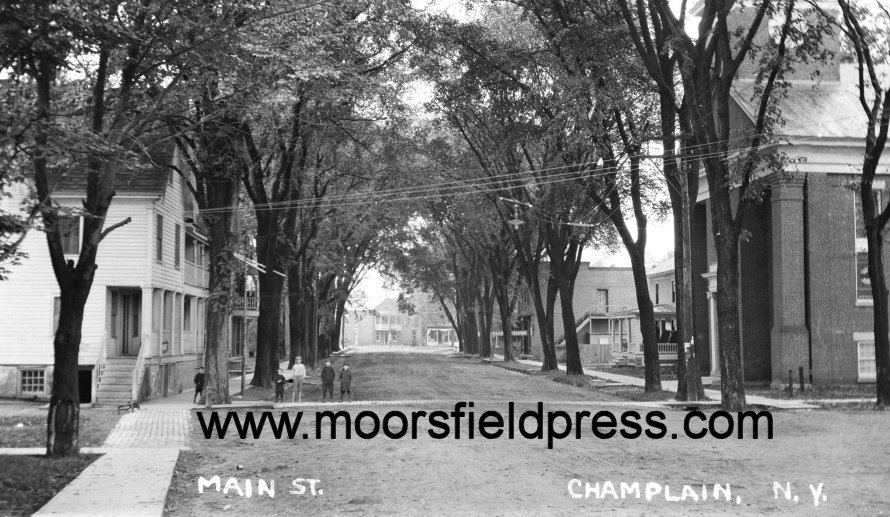
|
|
2016
Champlain Historic Calendar
_______________________________________________________________
The
Many Faces of Champlain:
A Photo Odyssey of Champlain and
Rouses Point
The 2016
Champlain Historic Calendar
details several well known
buildings in the area and
presents many never-before-seen
portraits of Champlain’s
residents. In Champlain, a
history of the Mansion House
(later the Costello Apartments)
on Main Street is given.
In Rouses Point, two important
tourist destinations are
examined: the former Windsor
Hotel (later the Saxony) and
Marnes Inn and Dock. The
Windsor Hotel was a summer
resort in the late 1800s and
early 1900s before it became a
popular dance and banquet hall
by the 1920s and into the
1980s. Marnes Inn and Dock
was established in the 1920s by
Dr. Charles Marnes and was also
a popular tourist spot. An
expanded 19 page pictorial shows
many photographs of Champlain
residents. Several family
group photographs show the
Bredenberg, Castine and
Thibodeau families.
Approximately 120 high-quality
studio portrait photographs from
circa 1904 show people with the
names of Albee, Bowron, Clark,
Dickinson, Dodds, Dudley,
Dupont, Duquette, Elvidge,
Falcon, Gettys, Hubbell,
Kaufman, Lafountain, Lavalley,
Lambert, Lewis, Lucas, McCrea,
Neverett, Roberts and Stone,
among others. There are
surely ancestors of today’s
residents in this collection of
studio portraits that have been
hidden from the public for 110
years.
|
|
|
This
calendar series has 13 large format
photographs (about 10in wide) and
smaller inset photos related to the main
photograph. The calendar is
printed on a high quality satin
(semi-gloss)
cream paper to give the images a true
photo look.
A
history is written about
each photograph and usually
includes extensive primary
sources and newspaper
references.
The 2016 calendar also has an additional
19 pages of
photographs in the back.
The below contact sheets show a sample
of the images in this calendar.
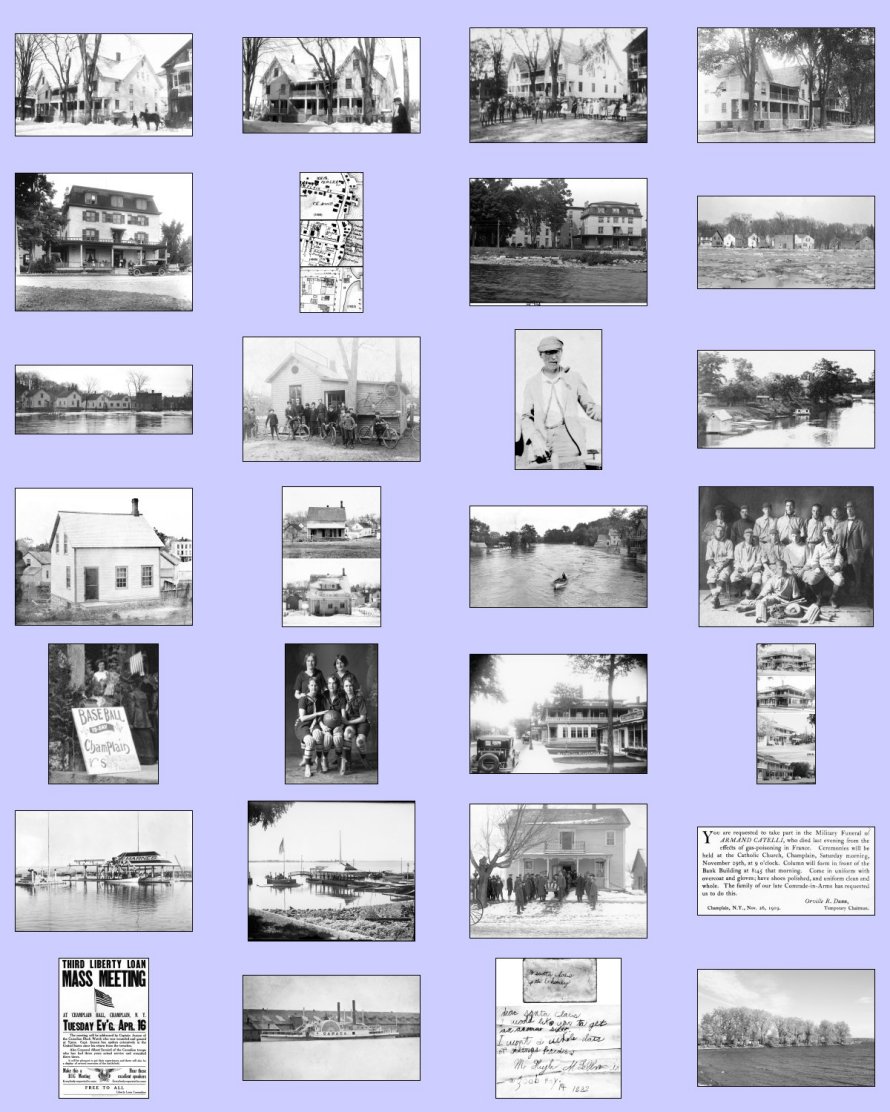
Monthly Image
Descriptions
(partial descriptions)
January
The Mansion House, Village of Champlain
The Mansion House and Commercial House.
The Mansion House was a large, three-story hotel
on Main Street in the Village of Champlain
opposite the Presbyterian Church (later the
Village Hall after 1928). It was one of
several hotels in the village that included the
Champlain House and American House, also on Main
Street. The hotel was built in 1848 and is
first mentioned in a letter from Laura Moore Nye
to her husband Bartlett on October 12, 1848 (the
builder of the Locust Hill residence, later
called the Savoy Hotel): “Bigelow has his
roof raised and it is almost as tall as the
church steeple.” In this letter, Laura
referred to John Bigelow, first proprietor and
builder of the hotel. The church steeple
was on the Presbyterian Church across the street
(rebuilt as the clock tower). By
1876-1881, J.B. Roberts was the proprietor of
the Mansion House. In July of 1884, the
house was leased to a Mr. Leland of Crown
Point. In the early 1900s, the house was
called the “Commercial House”.
Costello Apartment House, formerly the
Mansion House, with large garage and adjacent
lots. This property is located on Main
Street, at the corner of Main and Church streets
and runs through to maiden Lane. There are
eight apartments in this property, which, after
taxes and insurance are paid, brings a net
income way above any property in this
vicinity. This will be proven to anybody
interested in the purchase. A bargain at
the price I am offering. Ad in “The North
Countryman,” October 10, 1940.
February
Windsor Hotel, Rouses Point
The Windsor Hotel in Rouses Point was located at
the corner of Champlain and Lake Streets.
The hotel was very popular in its early days and
has been a gathering place for people for over
100 years under several hotel names.
Before it was a hotel, the building was a family
residence owned by a man named Webb of the firm
“Webb and Rawdon.” The firm was contracted
by the federal government to build Fort
Montgomery in 1843 but later went bankrupt when
the government briefly stopped the fort’s
erection in 1846. According to longtime
resident James B. Stearns who later owned the
building in the late 1930s, the original brick
building (seen in photographs here) was Webb’s
original house. The brick is said to have
been imported from England. The property
was purchased by John Angell. By 1854, the
residence was referred to as the “American
House” and was owned by B.C. Webster, according
to an edition of the Rouses Point Advertiser (he
owned it as early as 1847, this name is also
seen on Beers’ 1869 map). Webster died in
1871 at the age of 71 and is buried in Maple
Hill Cemetery. Webster’s hotel should not
be confused by the “American House” on Main
Street in the Village of Champlain which had the
same name. In 1860, George W. Angell
ran it as a hotel. In the late 1800s,
summer hotels such as the Hotel Champlain south
of Plattsburgh became popular with residents of
New York City, Albany and Montreal, and many
came to the Adirondacks and Lake Champlain to
vacation and escape the heat of the
cities. This prompted Theodore M. Leonard
(1841-1926) to purchase the hotel in 1884 and
convert it into a major summer resort for
tourists. Leonard later added the frame
annex behind the original brick building which
contained a large dining room. Leonard
chose a prime location in Rouses Point as the
hotel was close to the train station and a ferry
ran from a nearby dock to Vermont (at one time,
the railroad tracks ran parallel to the
shoreline in the water down to a new
dock). In April of 1884, Leonard hired
Abijah North, who was landlord of the Nye’s
“Champlain House” in Champlain, to remodel the
still named “American House.” The
renovation was a success and the “Windsor
Hotel”, as it was now called, was opened......
:
:
:
T.J. Chevalier Now Owner of Once Popular Hostelry
The Windsor Hotel at Rouses point, at one time one
of the largest summer resort hotels in Northern New
York, has been sold by the administrators of the
estate of the late J.B. Stearns to Thomas J.
Chevalier, of Hartford Connecticut, formally of
Rouses point. The hotel will be remodeled and
repaired and will be operated by Mr. Chevalier as a
summer resort. The
main part of the Windsor was built something more
than 70 years ago at his location on what is now the
Lakeshore Drive by the late George Angle, and it was
a popular summer hotel for several decades. Mervin
Andrews, a Mr. Taylor and Lawrence Marney were other
early operators. It was remodeled and the large
frame annex containing the dining room was added
when it was purchased by the late T.M. Leonard in
1882. Abijah North ran it for Mr. Leonard for
several years and other owners or tenants included
Charles Beck, Howe, Joseph Ripley, R.B. Mayo and the
late Joseph Goyette. James B. Stearns purchased the
building from the Goyette estate and Mrs. Ida Erving
reopen the hotel for a few months in the summer of
1943. Most of the furniture and furnishings were
sold at auction. [newspaper article]
March
This image shows the devastating 1911 flood.
The back of the houses on River Street are shown
with the Champlain Academy and Locus Hill residence
in the background. The square building in the
middle of the image was one of Bill Earls buildings
and had a sign on at that stated “WM. Earl Bicycle
Repair Shop.” Other photographs in this
calendar show the same buildings.
April
Bill Earl Park, Village of Champlain
The land surrounding River Street
has been used for many different purposes over the
past 227 years. Prior to 1829, it was a lush
riverside pasture for Judge Pliny Moore’s
cows. By the mid-1800’s, the riverbank was
used for commercial purpose. A store, marble
shop, warehouse and boat yard were built here.
By the early 1900s, many houses lined River Street
but only a few remain today due to past
floods. In the late 1800’s, a sawmill
was located at the end of River Street and was owned
by John Earl, father of Bill. Bill worked here
when he was young and later hauled sand from Lake
Champlain to the Sheridan Iron Works in a boat he
owned. Around 1906, Bill operated a small
bicycle repair shop near his house on the riverbank
and Champlain’s youth often had their bikes repaired
here. He also rented pleasure boats and owned
a small paddlewheel that cruised the river.
Bill was known to take children to see Lake
Champlain’s islands. Bill Earl died on May 15,
1943 at the age of 76 and his funeral was held in
the nearby funeral home. Hugh McLellan was one
of the pallbearers at the funeral. Hundreds of
children passed his casket and paid their
respects. He was buried in Glenwood Cemetery
with his family members.
:
:
:
May
This photograph shows one of the more dynamic houses
in the Village of Champlain. This small house
is found on Elm Street at the base of Prospect
Street today and looks very different from when it
was originally built. The earliest photograph
of the house shows it as a simple frame building on
a stone foundation with no porch. A later
photograph shows the same house with a front porch
and basic roof. A third photograph shows the
house with an extended roof over the porch and
dormer windows on the roof. The back of the
house has also changed dramatically since it was
built. An addition was added and this was
modified several times (note the changing shape of
the roof). In the early 1900s, Elm Street was
level with the front porch, but today, the road has
been raised significantly because of the constant
flooding on River Street. Additional
photographs of the house are shown in the back of
this calendar.
June
The Great Chazy River is shown looking east from the
Elm Street bridge (also known as the “Lower Bridge”)
in the Village of Champlain. On the north bank
is Bill Earl’s bicycle repair shop and his father’s
sawmill with smoke coming out of the chimney.
On the south bank is the back of the commercial
buildings on Main Street. Bill Earl owned a
small paddlewheel boat which is seen in several
photographs here. When the boat was not in
use, it was left on the bank by his building.
July
Sheridan Iron Works Employees, 1938
August
Village of Champlain Baseball Team
In the early 1900s, baseball was extremely popular
in Champlain and the surrounding communities.
Many posters were printed into the 1930s announcing
games between Champlain and rival teams. In
this photograph, the Champlain baseball team is
shown in 1913. The inset photograph shows a
sign on Main Street about 1911 that announced a game
with the Plattsburgh team. The second inset
photograph shows several girls from the Champlain
High School basketball team of the 1928-29
season. The captain was Dorothy Wright,
daughter of Champlain photographer M.L. Wright who
took this photograph.
September
Marnes Inn and Dock, Rouses Point
Charles Martin Marnes (1863-1939) was a doctor,
public official and large property holder in Rouses
Point. He was the son of John Edward Marnes
who was born in England and Margaret May Costello
who was born in Ireland. Charles had three
brothers named George, Edward and William and two
sisters named Mary and Margret. Charles grew
up in Chazy and graduated from the University of
Illinois, College of Medicine and Dentistry in 1886
and became a general practitioner and surgeon who
resided in Rouses Point. Dr. Marnes practiced
medicine for 35 years (1890 to 1935), was a
postmaster (1915-1921) and health officer in Rouses
Point (1890- ) and then operated the Marnes Inn and
dock as well as other properties nearby.
:
:
:
October
The Windsor, Marnes and Slingsby
Docks in Rouses Point
“In days gone by Rouses Point on Lake Champlain
was an attractive summer resort which hosted
many vacationers who returned year after year to
relax on its lakefront, rest at its two
well-known hotels, the Marnes' Inn located in
the business section of Lake St. or the Windsor
Hotel at the south end of the
village. Attractive features of
these two summer hotels were the docks which
extended out into the lake and offered a cool
haven for meditating. The Marnes Inn had a
covered dock where boats could tie up and where
benches were provided for those just wishing to
enjoy the scenery. Just north of the
Marnes Inn Dock was the Slingsby Dock, also a
covered dock with tie-up facilities and benches.
In between the two docks was an attractive
square pier where a cannon was mounted and a
flag pole which usually was topped by the
American Flag. The distance between
the three structures attracted many a lad and
lassie to try their first attempts at becoming
swimmers by dog-paddling the distances between
them and climbing up on any of the three to rest
or bask in the sun. Young fishermen
spent hours with homemade fishpoles catching
sunfish, perch and hunting for tadpoles in the
not too deep waters in the summer.
Early spring was another matter and the high
levels of the lake inundated the benches and
dock platforms and as the pictures show, the
area presented a bleak and cold looking scene,
with promises of better days to
come. The Windsor Hotel also had a
dock extending out into the lake and just north
of the hotel was a small park with evergreen
trees and a little attractive summer house,
where people liked to visit. Time changes
all things and Marnes Dock and Slingsby's Dock
and the quiet little park have all disappeared
now and only exist in the memories of those who
enjoyed them in the wonderful past.” [reprinted
from the article “Remember When”, The North
Countryman, February 24, 1972]
Advertisement: February 2, 1939, The North
Countryman.
FOR RENT - Four room apartment at Marnes
Inn. Automatic heat, built-in cabinets,
newly decorated. Large living room, dining
room, kitchen, bedroom and bath.
November
Armand Catelli Funeral, WW1 Veteran,
Village of Champlain
During World War I, many Champlain residents
served in the Army and Navy in Europe.
Poison gas was used during the war and thousands
were killed from the effects of it. Armand
Catelli (1899-1919) was a Champlain soldier who
succumbed to the lingering effects of a gas
attack in France. Armand was the son of
Pierre (1844-1937) and Dorila (1865-1931)
Catelli. Pierre lived at the top of Church
Street near the corner of South St. in the house
that was built by Dr. Julius Churchill, a
prominent doctor of Champlain in the
mid-1800s. Armand’s funeral was held in
this house on November 29, 1919. In this
photograph his father is shown behind the coffin
in the fur hat. Undertaker Elmer Deal, who
had a funeral business on Main Street, stands to
the right holding his hat. The extended
Catelli family continued to live in the
Champlain and Rouses Point area throughout the
last century. One prominent family member
was Paul Catelli who worked at the Sheridan Iron
Works and lived in Rouses Point. He also
had a son named Armand.
A second photograph shows the Armand Catelli
funeral procession on Church Street. The
small house to the left is still present and is
adjacent to Catelli’s house. This is not a
commonly seen photograph as it has never been
identified as being of the funeral.
December 3 - Armand M. Catelli, son of Mr. and
Mrs. Pierre Catelli, died at his late home on
Church St., November 25th. He was 20 years
of age and his death was the result of being
“gassed” in France while in the service of his
country. / He was a member of the 359th
Ambulance Company of the 90th Division. He
was on duty on the St. Mihiel, Meuse and Argonne
fronts, and became a victim of German
fiendishness on November 2nd, 1918, over a year
previous to his death. After being gassed
he continued his work of aiding the wounded and
went into Germany with the Army of Occupation
after the Armistice was signed./ When his
condition became serious he returned to this
country and secured his discharge at Camp Upton
in June. He preferred coming home to being
sent to a hospital and has suffered intensely
though everything possible was done for his
relief. / The funeral was held from St. Mary’s
Church Saturday morning and was largely
attended. He was buried with the military
honors. About four squads of the Champlain
American Legion under command of Lieut. O.R.
Dunn [Orville Dunn] acted as guard of
honor. They were assisted in the burial of
their late comrade-in-arms by a squad of the
63nd Infantry from Plattsburgh Barracks. A
volley was fired over the grave and the bugler
sounded taps. / Mr. Catelli was a great favorite
with his friends, and the whole community is
saddened by the sacrifice he has made for his
country. / The following out-of-town people
attended the funeral of Armand Catelli:
Mr. C.H. Catelli. Mr. Leon Catelli, Mr. Adolf
Masson, Mrs. E.A. LeMoine, Mr. and Mrs. E.H.
Lattinrille, of Montreal; Mrs. J.E. Hebert and
Miss Irene Hebert of St. Johns,
Québec. [Plattsburgh Sentinel,
December 5, 1919]
December
Station House Hotel with the Steamboat
“Canada”, Rouses Point
The Station House hotel was first discussed in
the 2014 Champlain Historic Calendar and several
drawings and maps were shown. The huge
one-and-a-half story building was built in 1852
by the Ogdensburg and Lake Champlain Railroad
Company on a 620 foot long by 100 foot wide
wharf. The building served as a railroad
depot, steamboat dock, customs house and
hotel. The first floor housed the railroad
depot on the west end, a customs house at the
east end by the lake and a large dining room for
guests. The second floor contained hotel
rooms. The Rouses Point Beacon noted that the
hotel was the “the mightiest edifice of which
Northern New York can boast." This
railroad depot and steamboat dock was used for
people arriving from or departing to St. Johns,
Quebec, Burlington and Whitehall as well as
other localities along Lake Champlain. On
August 12, 1870, a tornado or hurricane severely
damaged half of the depot. The west end
gable which contained the car house was leveled
and several cars were thrown from the
track. The main building had several
hundred feet of roof ripped off and the roof
over the main office was also damaged (other
buildings around Rouses Point were severely
damaged). The depot building was abandoned
and removed quickly afterwards. Years
later, dirt was used to fill in the wharf to
create a pier and the railroad built a warehouse
at the end of the pier. Afterwards, the
Rutland Railroad came into possession of the
pier, and in the 1960s, was sold to the Rouses
Point Sportsman’s Club.
In this rare image, the paddlewheel steamboat
“Canada” is moored at the dock. The
steamboat “Canada” was one of three steamers
owned by the Lake Champlain Transportation
Company that included the “United States” and
“America”. It was built in Whitehall, N.Y.
in 1853 and was the largest steamer on the lake
at 260 feet long and 33 feet wide. The
ship operated from 1853 to 1870 and now lays at
the bottom of a bay in Vermont with other
scuttled steamboats. By the end of the
1860s, the steamers “Adirondack” and “Montreal”
were also sailing on Lake Champlain. The
steamboat “Canada” was used to transport
soldiers from Rouses Point to Whitehall during
the Civil War. One regiment was composed
of 1,500 officers and soldiers and a second
regiment was composed of 1,100 men. The
troops were given space on deck as well as below
deck in special quarters. A member of the
142nd N.Y. Regiment Infantry wrote, “At Rouses
Point the convenient and capacious steamboat
Canada was in waiting, and in a very short time
the regiment was transferred, and the boat was
steaming through Lake Champlain. They will
obtain their arms at New York.”
This photograph was taken by W.B. Pierce, also
known as Washington Brooks Pierce. Pierce
was a dry goods dealer in Rouses Point and was
one of its first photographers. He may
have also taken several unidentified 1860s
photos shown later. Pierce was born in
Chelmsord, Massachusetts in 1841 and was living
in Rouses Point prior to 1863. In 1864,
Pierce married Nancy Addie Wright but she died
two years later on March 7, 1866, at the age of
22 and was buried in Maple Hill Cemetery in Lot
25. Pierce then married Maud May Green who
was born in 1851. Unfortunately, Pierce
died on September 7, 1875, at the age of 34 and
was buried in Maple Hill Cemetery. A child
named Nydia Maud Pierce is also buried in
Pierce’s Lot 25 and she died on August 11, 1876
at the age of one but her parents were H. and
H.A. Bissell. She has the same name as
Pierce’s second wife and may have been adopted
by the Bissells after Washington died.
Pierce was a member of Christ Church in Rouses
Point and had one daughter named Emma from his
first wife. |
|
A sample of images
found in the
expanded 19 pages in the back of the calendar
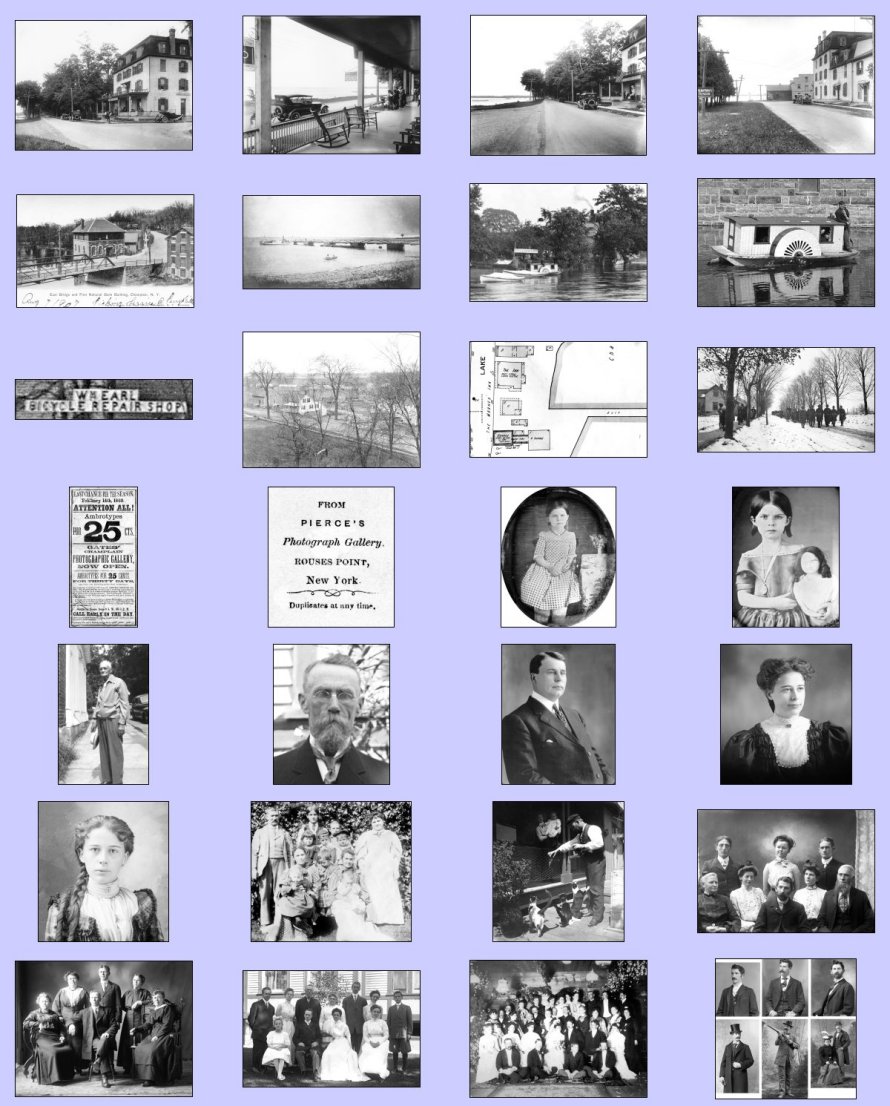
Elizabeth Nye McLellan (1840-1914) - two photos of the
child shown above (one with doll)
These two daguerreotypes are included here because of
their remarkable age and clarity. The young girl
pictured here is the mother of Hugh and Malcolm McLellan
and great-great grandmother of this author. She was
born in Champlain on November 8, 1840, the daughter of
Bartlett and Matilda (Moore) Nye. The photos show a
girl about five to seven years old which would date the
images to 1846-7, and to the dawn of photography.
The daguerreotype was invented in France prior to 1839 and
by the early 1840s was prevalent in the United
States. One characteristic of this technique is the
clarity of the image. The daguerreotype image has an
extremely high resolution that surpasses today’s film and
digital photography because it is printed on a silver
plated copper plate instead of paper. These 170 year old
images were either taken in Montreal or Burlington or by
an itinerant photographer. P. Tenney Gates was a
prominent Plattsburgh photographer but he did not get into
the daguerreotype business until 1850. Parts of the
oval photograph was hand painted.
L. P Case was a photographer in Champlain in the 1860s and
1870s. He took many portraits of people.
Unfortunately, little information about him has been found
in the archives.
_____________________________________________________________________________________________________
Paine's
Studio Portraits
Champlain, New York
Approximately
120 high-quality studio portrait
photographs that date to about 1904 show
people with the names of Albee, Bowron,
Clark, Dickinson, Dodds, Dudley, Dupont,
Duquette, Elvidge, Falcon, Gettys,
Hubbell, Kaufman, Lafountain, Lavalley,
Lambert, Lewis, Lucas, McCrea, Neverett,
Roberts and Stone, among others.
There are surely ancestors of today’s
residents in this collection of studio
portraits that have been hidden from the
public for 110 years.
Two groups of contact sheets are shown
below. The calendar has five pages
of contact sheets similar to the two
shown here. Many more names of
people are on the other contact
sheets.
The original glass plate negatives are
owned by the Clinton County Historical
Association in Plattsburgh and have been
scanned at high resolution.
Contact
the association if you would like a
copy of one of the portrait images.
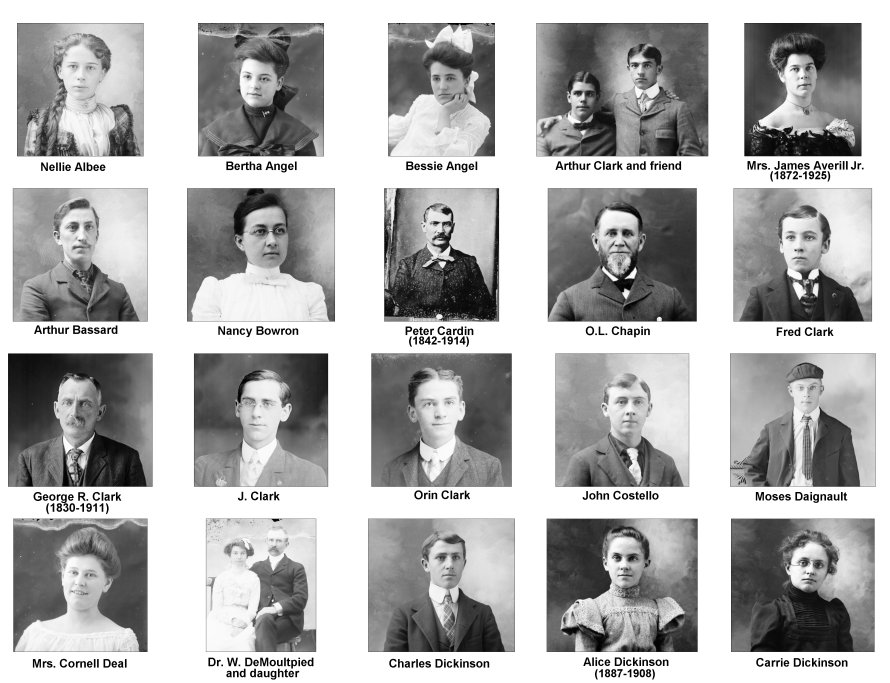
_____________________________________________________________________________________________________
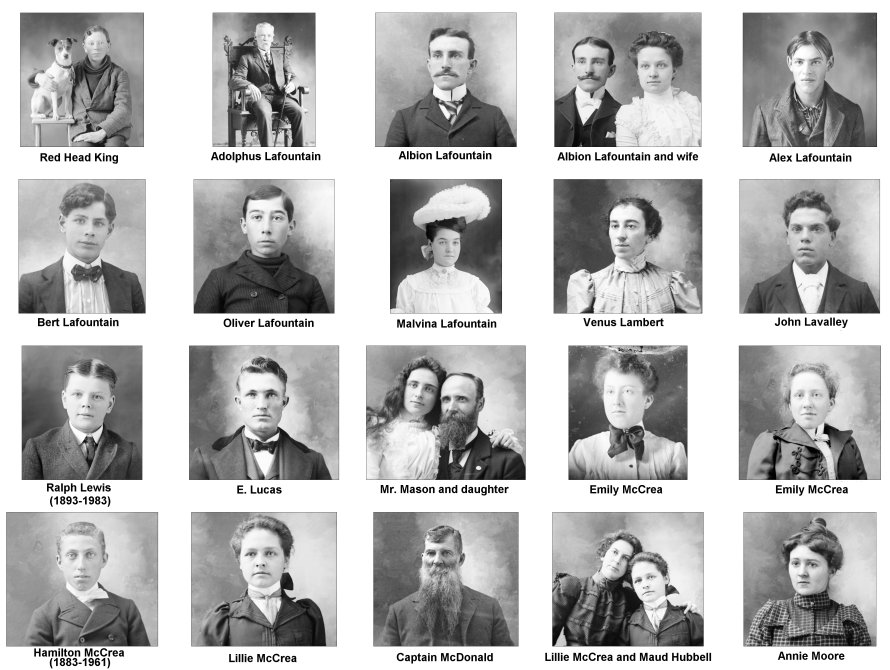
Bert
F. Paine and “Paine’s Studio”
Main Street, Village of Champlain (1898-1910)
Bert F. Paine was
originally from Burke, N.Y. and settled in Champlain in
January of 1898. He purchased a lot on Oak Street near
Maple Street and built his residence here. The
house included a small photography studio inside.
His studio was not there long and in April of 1904 he
moved it to the Doolittle building on Main Street (the
brick building to the left of Champlain Hall later called
the Mauer building). Paine was there until the
spring of 1909 when he moved to a frame house, formerly
the store of S. Legendu (or Legendre), that was located to
the left of the Champlain House. Between 1906 and
1910, Paine took many celluloid negative photographs
around the village and town of Champlain and used these to
make postcards and prints. Inside his studio, he
took formal portraits and made cabinet cards or mat framed
prints. A circa 1910 photograph of Paine’s studio
shows a postcard advertisement displayed in the window
with hundreds of postcards and portraits hanging on the
wall inside. In 1909, Paine had an assistant named
Myron L. Wright and he took over Paine’s business when he
left Champlain in May of 1910. The 2012 Champlain
Historic Calendar had more images of Paine and his
studios.
|



